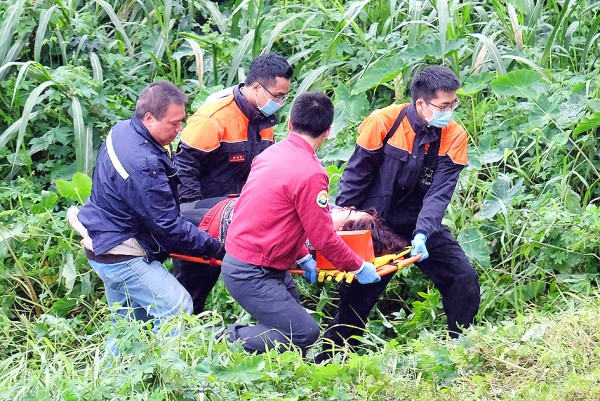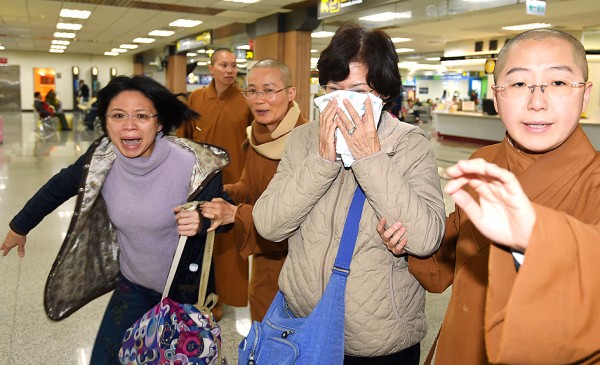《TAIPEI TIMES 焦點》 Eighteen people still missing after TransAsia crash

An injured passenger is carried by emergency personnel up the river bank after a TransAsia ATR 72-600 plane crashed into the Keelung River yesterday. Photo: Sam Yeh, AFP
Twenty-five of the 58 people aboard TransAsia Airways Flight GE235 that crashed into a river in Taipei yesterday before noon have been confirmed dead, according to the Taipei City Government’s Emergency Operations Center as of 10pm.
Fifteen were injured and 18 remain unaccounted for, it added.
Ten of the victims had lost vital signs before arriving at hospitals.
An out-of-hospital cardiac arrest (OHCA) victim was resuscitated by Tri-Service General Hospital medical personnel, but later died from multiple traumas, despite intensive treatment, the hospital’s emergency unit director Lan Kuo-cheng (藍國徵) said.
Aside from the female patient, the hospital received six other crash victims, including three OHCA victims, who were later pronounced dead, in addition to two male and one female patients, all Taiwanese, whose conditions had stabilized after suffering fractures and multiple lacerations.
Another six passengers were rushed to Taipei City Hospital’s Zhongxiao Branch, including an OHCA patient; a 38-year-old man surnamed Huang (黃), who suffered multiple fractures and remained in critical condition at press time; a 34-year-old mother, who sustained mild wounds; and her 15-month-old child, who experienced a potentially dangerous drop in body temperature and was placed in intensive care.
“Also being treated at the branch is a 52-year-old taxi driver surnamed Chou (周), whose face and eyes were injured by fragments of windshield glass after his vehicle was hit by the plane, and his 26-year-old female passenger. Both of them were only slightly injured,” Taipei City Hospital spokesman Chen Chia-chieh (陳家傑) said.
Four of the victims were admitted to Tri-Service General Hospital’s Songshan Branch, including a 10-year-old girl surnamed Yan (顏), while a 26-year-old female cabin attendant, surnamed Huang (黃), was being treated at Taipei Medical University Hospital’s (TMUH) intensive care unit for rib fractures and lung and kidney contusions.
Two more victims were sent to TMUH.
One of them had lost all vital signs before arriving at the hospital, while the other had surgery for pelvis fractures and an arterial rupture.
Four of the wounded passengers were rushed to Sijhih Cathay General Hospital, including two cardiac arrest victims and two middle-aged men, while a 50-year-old Taiwanese passenger who sustained bruises and lumbar wounds was still being monitored at Taiwan Adventist Hospital at press time.
Two OHCA victims were sent to Cathay General Hospital and the Taipei City Hospital’s Renai Branch, but neither of them recovered.
Taipei’s Emergency Operations Center was mobilized in response to the accident, with Taipei Mayor Ko Wen-je (柯文哲) heading to the center directly after being notified.
Rafts crowded around the plane crash as rescue personnel sought to pull passengers from the wreckage, while boats crisscrossed nearby and helicopters hovered overhead in search of victims in the river. By evening, the Taipei Fire Department reported that 1,663 personnel from Taipei, New Taipei City, Keelung and the military were working at the rescue site, with 408 emergency vehicles and 80 boats.
One of the frontline rescuers from the Taipei Fire Department, who requested anonymity, said that when he arrived at the scene, eight passengers, including a child, had already climbed out of the plane, with some floating near the plane and the others standing on it waiting to be rescued.
“When I entered the cabin, a strong smell of gasoline immediately came out. The cabin was flooded with chest-deep water ... and the seats were severely deformed. Many passengers were tangled up in their seat belts and hung upside down. Some even passed away in that position,” the rescuer said.
He said the priority for him and his colleagues was to rescue those who were still alive, but it was not an easy task, because they had to remove obstacles before they could reach the survivors, put them in life jackets and carry them out of the plane.
“We saved a total of 13 people in the first wave of our rescue mission, including five from inside the cabin and eight who made it out of the plane alive themselves,” he said.
After the initial rescue effort, further progress was slow.
“The plane’s body and seats had been so badly deformed that only one or two rescuers could enter, which slowed the pace of the rescue,” Taipei Fire Department interim chief Wu Chun-hung (吳俊鴻) said.
Wu added that the murky river water made it difficult to spot victims outside the plane.
Rescuers were pressed for time with water completely filling the plane’s carriage by evening.
Although two military amphibious rigs and two cranes were brought in to pull the plane from the riverbed onto the shoreline, efforts were delayed, as one of the crane’s protective steel cables snapped.
新聞來源:TAIPEI TIMES

Buddhist nuns try to console family members of passengers on TransAsia Airways Flight GE235 at the company’s counter at Taipei International Airport (Songshan airport). Photo: Liao Chen-huei, Taipei Times




















